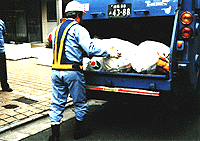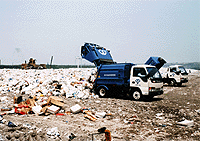



The seemingly unstoppable growth in the volume of waste produced by households and corporate offices came to a halt in fiscal 1992 (April 1992 to March 1993) for the first time in nine years, according to a report recently issued by the Ministry of Health and Welfare.
Total nonindustrial waste in fiscal 1992 came to 50.2 million tons, 1.1% less than the preceding year. The primary factors in the decline are the increased volume of items that were recycled and the slump in the Japanese economy, which dampened purchases.
Waste in Japan is classified into "industrial waste," consisting of used building materials, sludge, and other items produced by industrial activity, and "general waste," consisting of all other discarded items. Municipal governments are responsible for collecting and disposing general waste, while the disposal of industrial waste is the responsibility of the enterprise that produced it.
While some of the collected waste is recycled, the majority is first incinerated, reducing their volume, and then buried in landfills.
The Health and Welfare Ministry report covered general waste, whose volume had been growing steadily since fiscal 1984. In fiscal 1992, however, the total declined by 570,000 tons from the preceding year.
On a per capita basis, each Japanese resident threw out an equivalent of 1,400 grams of trash every day. This is 1.3% less than the figure for the previous year and represents the second straight year of decline.
The volume of waste that was recycled amounted to 1.9 million tons, a rise of 240,000 tons, or 14.2%, over the previous year. While not covered in the ministry's survey, the volume recycled by volunteer citizens' groups reached 2.2 million tons, 1.5 times the total collected in the previous year.
Some 7.3 million tons of waste were taken to landfills, a decline of 1.1 million tons, or 13.4%, from fiscal 1991. This indicates that more discarded items are being recycled and incinerated.
The cost of waste disposal has shown no signs of leveling off, however. Municipalities spent 2.2 trillion yen, or 267.8 billion yen more than the previous year, to treat and dispose of waste and raw sewage, exceeding the 2- trillion-yen-mark for the first time. This averages to 14,800 yen per person and 44,300 yen per household.
Perhaps an even bigger problem than rising costs is the difficulty of finding new landfills. Efforts are being made at national and local government offices, consequently, to recycle more and to throw away less, and they are encouraging individuals and businesses to do likewise.
(The above article, edited by Japan Echo Inc., is based on domestic Japanese news sources. It is offered for reference purposes and does not necessarily represent the policy or views of the Japanese Government.)